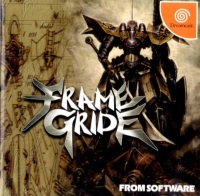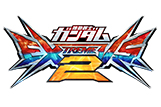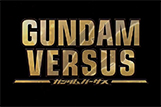Reviews: Frame Gride (6/10)
Posted on : 03-08-2014 | By : Cacophanus | In : Reviews
Hardware: Dreamcast
4
 Upon booting the game, the player will be asked a set of cryptic questions, in Japanese no less, on how they want their “cavalier” to be equipped. Will you choose either the Varmonch and Lutheran Shield, or even the Minenwerfer? Bear in mind though, that if you choose poorly Lord Zolt’s forces will make you pay dearly for your lack of foresight. After all, the realm’s destiny lies at your heavily armored Cavalier’s feet. To clarify, Frame Gride is a slightly different take on the mecha genre of gaming.
Upon booting the game, the player will be asked a set of cryptic questions, in Japanese no less, on how they want their “cavalier” to be equipped. Will you choose either the Varmonch and Lutheran Shield, or even the Minenwerfer? Bear in mind though, that if you choose poorly Lord Zolt’s forces will make you pay dearly for your lack of foresight. After all, the realm’s destiny lies at your heavily armored Cavalier’s feet. To clarify, Frame Gride is a slightly different take on the mecha genre of gaming.
Anyone familiar with the mecha genre in general will realise that it has many niches and subsets within it. Frame Gride is set in the fantastical branch of mecha, very much in the same vein as Dunbine and Galient. As such, you are placed in the mythical land of Rood where Emperor Regilio has recently passed away, without denoting who shall inherit the realm. Lord Margrave Zolt has other plans, though, and they don’t involve love and kindness. Thankfully, you have appeared on the scene, and Archbishop Melange thinks you’ve got the right stuff to overthrow a zealous dictator such as Lord Zolt. You are knighted and awarded your Cavalier accordingly. Your mission: defeat Zolt and bring peace to the troubled realm of Rood.
The pseudo-medieval setting aside, Frame Gride is a rather eclectic title. The uninitiated may make comparisons to From Software’s other mechanical franchise, Armored Core, but these would be woefully inaccurate. Indeed, both games involve giant robots and both games have the player controlling them via a third person perspective, but the focus for each game is drastically different.
Frame Gride’s emphasis is squarely focused on two player versus. It was one of the first online capable games in Japan for the Dreamcast and the entire, offline, game is based around arena-esque encounters with enemy Cavalier mecha. Melee combat is also considerably more developed compared to Armored Core. In essence, Frame Gride is more of an arcade battler than a sit-down mission game. So whilst the two games may visually appear very similar, they play considerably differently to one another.
One similarity both games share is that of having an extensive library of parts for the player to choose from. That being said, Frame Gride’s implementation of its parts library is rather special. To explain, upon the destruction of an enemy jewels will be produced. These jewels can then be physically combined with other jewels to create parts. Acquisition of different jewels allows the player to deck out their mechanical Cavalier with ever more surreal and outrageous weaponry. Not to mention that some jewels are painfully rare, making the acquisition of certain parts a nigh on obsessive experience.
Following on from this, jewels not only create parts for your Cavalier but they also manufacture Squires. The latter is probably one of the most interesting aspects of the game. Squires come in many shapes and sizes and with varying abilities and shortcomings. They operate under their own power, but their deployment and usage is still very much a tactical one. Woe betide any opponent that ignores a Squire. They are a force to be reckoned with and whilst not capable of winning a battle outright, judicious usage of their abilities may turn the tide considerably in your favour.
Aside from all these weapons and Squires, jewels can also be used to create Liberate stones. These add certain functionality to your Cavalier. An interesting development, though, is that of having elemental Liberate stones. Equipping a Fire elemental will mean that you will do good damage but open to attack from an opposing element, such as Water. Not to mention that you will be less mobile compared to a Cavalier with a Wind elemental equipped. This adds an interesting dimension to versus combat.
Graphically, Frame Gride is also rather impressive, especially for a Dreamcast game. Admittedly, it has no real bearing on the gameplay, but many of the environments and weapon effects are incredibly sumptuous and give a certain sense of fantastical immersion, to the point that the medieval mecha feel almost tangible.
For all its many good points, though, Frame Gride is still somewhat lacking. The controls are particularly clumsy for one. This is partly due to the fact that the game fails to choose whether the lock-on system or free-look has priority; neither system is fully offered to the player. This means that the controls are made overtly ambiguous and make tracking an enemy unnecessarily hard in most instances. This is a crying shame, after all the melee, mid and long range combat is particularly solid, but getting to that and simply taking aim on a foe takes considerable and unnecessary effort.
The controls are not all that is lacking either. The game itself is still rather bland and doesn’t offer much in the way of opponent diversity. Not to mention that the game would have benefited from being something other than a beefed up arena. More interactivity with the environment and world setting would have grounded the game a lot more. Admittedly, the back-story helps to add some context and the implementation of the Cavaliers is handled in a novel way, but it simply isn’t enough. After all, you are fighting other knights who obviously have kingdoms, yet you don’t see much in the way of their subjects, and it makes Rood feel rather lifeless. Considering how much potential this setting had and how much effort obviously went into the initial back-story, it is a pity that it wasn’t maximised to the fullest.
This is not to say that Frame Gride is a bad game, but is most certainly an opportunity lost on the part of From Software and very much of a title that could have offered a whole lot more. Even so, as a combat game it is worth a look, regardless of whether you want to pilot vast mechanical knight or not.
Tamashii: 6/10











Good review, I agree with all points. It’s a fun game but definitely some missed opportunity on the lore and perhaps some sort of cool single player mode where you conquer the land and expand your kingdom; such as missiosn that did not just involve outright going after enemy knights but also ridding the land of beasts and other fantasy such things that could threaten your kingdom or it’s expansion (and tying into dropping rare gems)
I remember playing this when it first came out; the Dreamcast flopped so hard in the Netherlands, that I was able to buy the console for 99 bucks including 3 games of choice merely 8 months after it was released (!!!!!!!!!!) The store I bought I from, Fame Music also did imports so Frame gride was one of the games lying in the junk bin for the DC which i instantly picked up. I mean i couldn’t read anything on the box but giant iron knight + from software = yes ?!
Sure the controls were clunky; to say at best. But already having been used to finger-crunchers like the original Armored core; you tend to not complain as much as most generic gamers. What did my head in though; was the extremely long loading times on the DC before each match, a good 90 seconds if not at least two minutes :-/ – that combined with the incredibly annoying loud noises of the GD-Rom drive. gah,
I really burnt out on the game, having played it for months almost exclusively, and never picked it up again after i completely mastered it. But after reading this review I kinda feel like going back to play it for the unique setting.
Thanks, the review is almost 10 years old actually. Just pulled it from my archive when I realised the site didn’t have it! 😀
I had forgotten about this game. I had wanted to import this back in the day, but never had the money to really afford it. In hindsight now, I’m glad I didn’t, it looks like with out the boosting mechanic from Armored Core (or a dashing mechanic), it’s very difficult to keep your opponent locked on. I probably would’ve gotten frustrated with this and went back to Virtual-On. While the designs of the mechs and the graphics look good, the arena you fight on seems very bland. The music doesn’t really seem all that special either.
Just makes me wish for a Wares Blade video game that mixes Monster Hunter with Front Mission and a sim/exploration game.